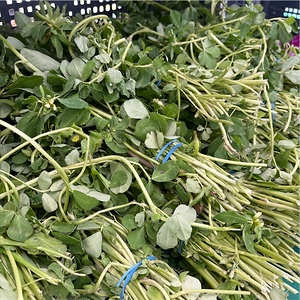


Alfalfa Greens
Estimated Inventory, bunch : 0
Description/Taste
Alfalfa greens grow anywhere from 30 centimeters to one meter high. Long, round stems grow up from a multi-branched crown, developing multiple off-shoots themselves. Each stem bears clusters of three thin, elongated leaves at intermittent spots along the stem and at the ends. The leaves have an appearance similar to clover. At maturity, the plant produces one-sided clusters of purple, white or yellow flowers, depending on species. Alfalfa greens have a mild flavor, with a slight sweetness and no bitterness. Alfalfa is a sustainable plant, tolerant to grazing and cutting, some plants living for over 20 years.
Seasons/Availability
Alfalfa greens are available year-round with peak seasons in the spring and fall months.
Current Facts
Alfalfa greens are known botanically as Medicago sativa, and they are classified as a legume. They are also known as Chilean Clover, Buffalo Grass, Purple Medic, and Lucerne. Alfalfa greens are considered the "Queen of forages,” referring their high levels of protein, fiber, vitamins and minerals making them ideal for use as feed for livestock. The name Alfalfa comes from the Arabic word “al-fal-falah,” which meant ‘father of all foods’.
Nutritional Value
Alfalfa greens are very high in protein and dietary fiber. They have the highest chlorophyll content of any plant and contain large amounts of enzymes, making the greens easily digestible. Alfalfa greens are a good source of vitamins C, E, and K, as well as iron, calcium, magnesium, and phosphorus. They are also a source of potassium, trace elements, and essential amino acids. Alfalfa greens also act as a diuretic in large doses.
Applications
Alfalfa greens can be used raw, cooked or dried. Fresh Alfalfa greens can be juiced or blended into a fruit or green smoothies. They can be sautéed or added to soups, stews or stocks. Alfalfa greens can be dried and used to make teas or used as an herb. The dried greens can be ground into a powder and used to add additional protein, fiber, vitamins and minerals to breads or other baked goods. Store fresh Alfalfa greens in the refrigerator for up to a week. Dried Alfalfa greens can be stored in an airtight container for up to three months.
Ethnic/Cultural Info
Alfalfa has been used for centuries as a medicinal herb. Native Americans utilized the whole plant, especially the seeds, and physicians during the 19th century used the leaves as an ingredient in tonics. Traditional Chinese medicine uses Alfalfa leaf as an appetite stimulant and to relieve digestive troubles. Colonial Americans used the plant as a treatment for scurvy, arthritis and to relieve water retention. Today, Alfalfa greens appear in a variety of different products like liquid chlorophyll, an herbal dietary supplement, and is used to fortify baby food and other diet foods. Dehydrated Alfalfa greens are used in processed, concentrated feed for chickens, cattle and pigs.
Geography/History
Alfalfa dates back nearly 6,000 years to present day Iran. The plant was used by the Persians, Romans and Greeks and was written about by Aristotle. Spanish and Portuguese explorers brought Alfalfa to the New World during the 16th century. It was planted in Virginia by Thomas Jefferson and George Washington, who referred to it as Lucerne. The plant was ill-adapted to the climate there and it didn’t thrive. During the 19th century, Alfalfa greens were introduced to California via Chile as Chilean Clover, and to the Midwest by Wendelin Grimm, an emigrant from Germany. Alfalfa greens are often used as a rotation crop by farmers; it has nitrogen fixing capabilities and can restore nitrogen to the soil. It is more commonly allowed to dry and turn into hay, which is then used for cattle and livestock feed. Due to its popularity as feed, during the period between 1962 and 1992, over 440 different cultivars of Alfalfa were developed, each for different climate and purpose. Alfalfa greens are not commonly found in grocery stores but may be spotted at farmer’s markets, specialty stores, and backyard gardens.
Recipe Ideas
Recipes that include Alfalfa Greens. One
| BBC Good Food |
|
California quinoa & avocado salad |









